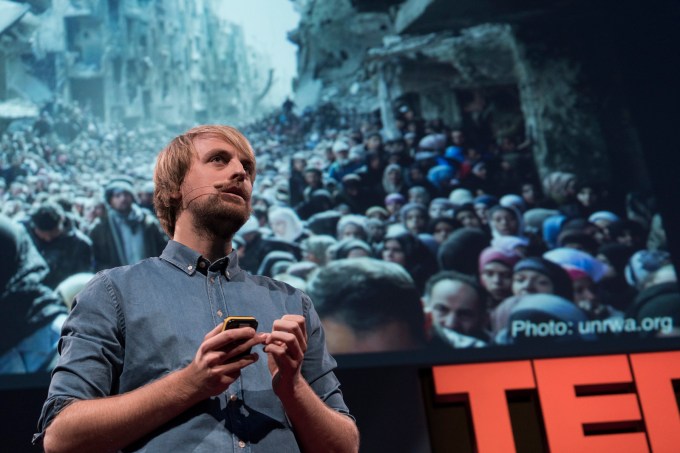
Journalist Anders Fjellberg told the heartbreaking story of how he identified two Syrian men who had attempted to swim the English Channel. Their bodies washed ashore, wrapped in cheap wetsuits, on beaches in Norway and the Netherlands. This take on the refugee crisis moved the audience at TEDGlobal>London. Photo: James Duncan Davidson/TED
In 1831, Michael Faraday stood in a lecture hall and demoed an idea that changed everything: electromagnetic induction. This work paved the way for widespread use of electricity.
On September 29, 2015, in the same lecture hall, attendees gathered for TEDGlobal>London to hear more ideas with the potential to shift reality. Sixteen TED speakers shared insights on the issues that matter most in the world right now: the refugee crisis, poverty and ethical science. Oh and, of course, spam email.
Read recaps of the talks given in Session 1…
Embrace the mess. Keith Jarrett’s Köln Concert is the best-selling piano album of all time. But the day of the concert in 1975, it careened toward disaster. The opera house delivered the wrong piano — the black notes stuck, the white notes were out of tune and it wasn’t big enough to drive the sound needed. Jarrett wanted to cancel. But he didn’t. Instead he played, working with the piano’s constraints. The performance was a revelation. Tim Harford, the “Undercover Economist,” sees a lesson in this. “We need to gain a bit more appreciation for the unexpected advantages of having to cope with a little mess,” he says. Disorder and disruption can propel good creative work, and Harford shares several psych experiments that point to this conclusion. “Disruptions help us become more creative, but we don’t feel like they’re helping us — we feel like they’re getting in the way,” he says. He gives one final musical example — producer Brian Eno and his deck of Oblique Strategies, which include tactics like having musicians switch instruments. “Sometimes all of us need to sit down and try to play an unplayable piano,” he says. Watch Tim Harford’s TED talk >>
Architecture as an organism. Ole Scheeren doesn’t just design and construct buildings — he tells stories, creating scripts and narratives for the people inside. As he shows five structures he helped design, Scheeren illustrates how architecture can exceed the physical domain of the built environment and focus instead on how people engage with reality. Eschewing traditional architectural conventions, Scheeren asks if buildings — specifically skyscrapers — can be about collaboration instead of isolation and hierarchy. Take the CCTV Headquarters in Beijing, an office building designed in the form of a loop which provides a workspace for the 10,000 employees. Or The Interlace, a residential space in Singapore patterned as a hexagonal grid with huge outdoor spaces. Scheeren’s projects are a hybrid of the technical and the social, and he is constantly thinking about the characters inhabiting his buildings — where they would meet, what they would experience. “We no longer live in a world that is clearly delineated,” says Scheeren. “We live in a world in which boundaries have started to blur.” Watch Ole Scheeren’s TED talk >>
What’s missing from the welfare system? In 1942, The Beveridge Report became a bestseller. No, it wasn’t about coffee or tea. This pamphlet written by Sir William Beveridge outlined the architecture of the first welfare state. Its concepts rippled out into the world, says social entrepreneur Hilary Cottam, and it made impersonal bureaucracy the standard for care of the needy. This system works — to a point. But it favors forms and assessments over real conversations and connections. When many care workers visit someone in need, they spend most of their time managing the system rather than really working with the people. “The system is like a costly gyroscope that just spins around families, keeping them stuck exactly where they are,” says Cottam. So, what’s the alternative? Cottam wants us to move toward “relational welfare” — the creation of social meshes that are based on human connection. These systems can be far more effective, and much cheaper, when it comes to big issues like unemployment, cyclical violence and the loneliness experienced by the elderly. “It’s all about relationships,” she says. “Relationships are the critical resource we have.” Watch Hillary Cottam’s TED talk >>
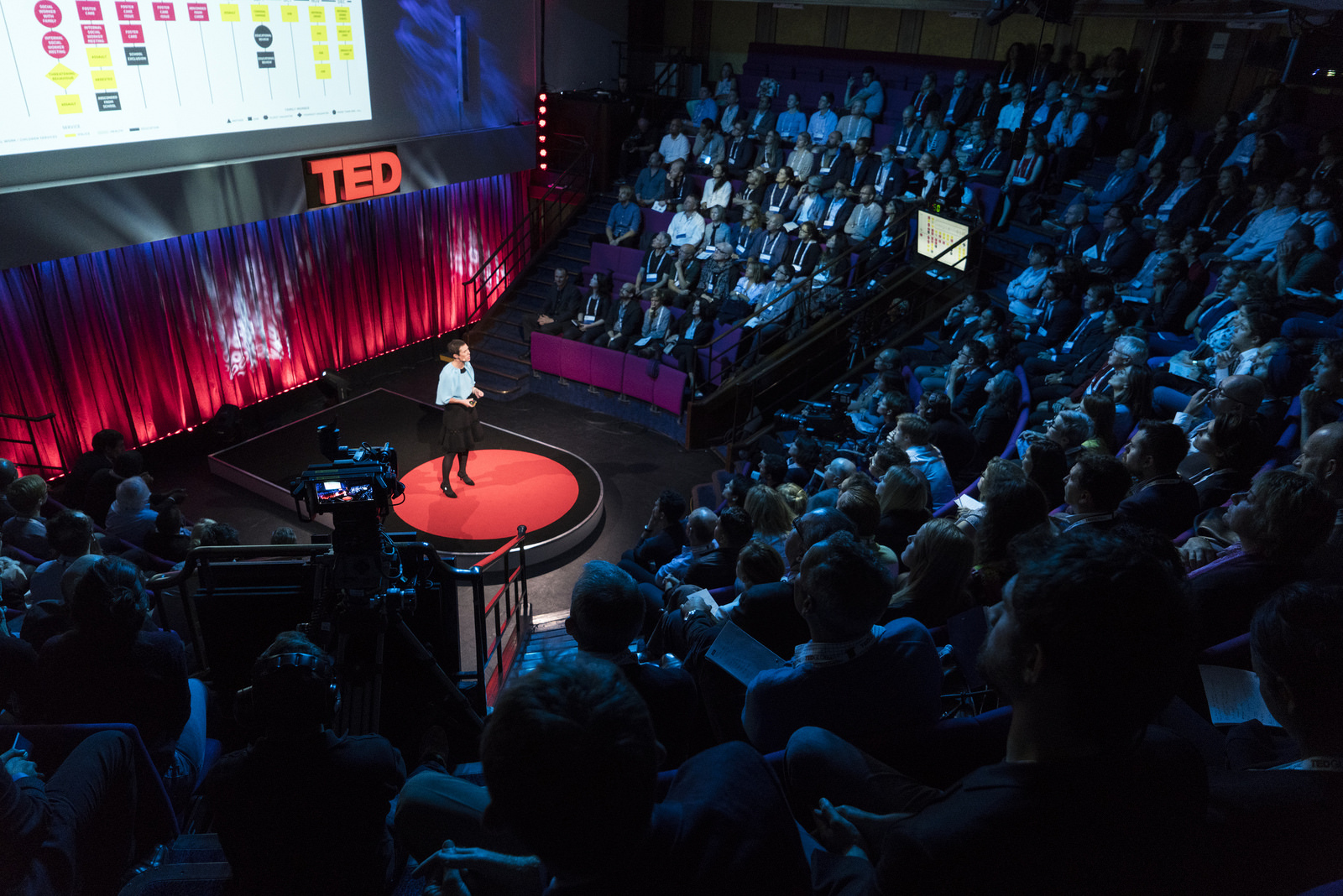
Hilary Cottam wants to see the welfare state redesigned to take into account human connection. Photo: James Duncan Davidson/TED
Pulling back the curtain on sovereign debt. Haircut, reprofiling, restructuring, refinancing, rollover. These are the terms that make people’s eyes glaze over when trying to understand sovereign debt — the much talked-about but seldom understood public finance phenomenon by which countries finance themselves. Jill Dauchy advises governments on debt and, in a Q&A with TEDGlobal curator Bruno Giussani, she reveals the patterns of governments that run into debt trouble and the perception that debt negotiations are a murky business. “What’s changing today is the nature of the governments getting intro trouble,” Dauchy says. “It used to be a problem in emerging markets. But today, from the European perspective, it’s getting closer to home.” Read more about Jill Dauchy’s talk >>
Two migrants’ lethal gamble for a better life. Norwegian journalist Anders Fjellberg was determined to solve the mystery of two dead bodies, clothed in cheap wetsuits, that had washed ashore, one in Norway and one in the Netherlands. Through persistent investigating, he evetually identified them as two Syrian men who’d tried to swim the English Channel in a desperate bid to gain asylum in the United Kingdom. Fjellberg retraced their journey from a ravaged district of Damascus to an overcrowded refugee camp in Calais, dubbed “the worst refugee camp in Europe.” It was here that Fjellberg discovered “the reality of living as a refugee in Europe in 2015,” he says: thousands of migrants contending with hunger, scabies and an interminable wait for passage to the UK. “Go to Calais and talk to the refugees,” he says, “and you will meet lawyers, farmers, engineers — the full spectrum,” he says. Gradually, Fjellberg says, the motivation of these two Syrian men came into focus. While some have said this is a story about death, “I don’t agree,” Fjellberg says. Instead, it throws into relief two life-affirming questions: “What is a better life? And what am I willing to do to achieve it?” Watch Anders Fjelberg’s TED talk >>
Girl with guitar. Emily Barker has recorded lush, studio versions of her songs. But for her new album The Toerag Sessions, she went analog, recording on 2-track tape — peeling it back to just her, her guitar and, sometimes, a harmonica. She treats us to a performance of “Nostalgia,” with the kind of intimate, heartfelt delivery usually found around a campfire.
The importance of the pre-mortems. Many of us have done post-mortems at work. But what about a “pre-mortem?” Neuroscientist Daniel J. Levitin sees pre-mortems as an essential tool because, when we’re in the moment, experiencing stress, our thinking gets cloudy (and we don’t know it because, um, our thinking is cloudy). Instead, plan ahead for stress: “Look ahead and try to figure out all the things that could go wrong and what you can do to prevent all those things,” he says. The idea is to systemize potential pitfalls. One simple example: At home, designate one set place for the things you always lose. “The hippocampus … is an exquisitely evolved mechanism for finding things,” he says. “But not so much for things that move around.” Or, for instance, before going to the doctor’s to get test results, make a list of the questions you need to ask in order to make calm, rational decisions. (If prescribed a drug, for instance, he suggests asking for a piece of data doctors don’t like to talk about, the “number needed to treat.”) “All of us are flawed, all of us will fail,” he says. “The idea is to think ahead of what those failures might be and put systems in place that will help minimize the damage.” Watch Daniel Levitin’s TED talk >>
A report card for the world. The UN’s 17 Global Goals, unveiled this month, are not just an exercise in wishful thinking, says Michael Green. Think the world can’t end poverty by 2030? Just consider the ambitious goals the UN set in 2000, and know that the world leapt ahead of many of the benchmarks set. “The pessimists and doomsayers who think the world can’t get better are simply wrong,” Green says. But, to reach this next set of global goals, world leaders need to broaden their focus beyond GDP. Three years ago, Green and his team unveiled the Social Progress Index, a set of indicators that measures the world’s progress in civil rights, education and environmental protection, among other issues that slip under the GDP’s radar. This year, Green will roll up the measures into the “People’s Report Card,” to show the world and individual countries how they’re doing. In 2015, the world gets a C-. But world leaders have committed to working toward an A. The intention is to hold leaders accountable on these vital, neglected measures. “Even a flood tide of economic growth is not going to get us there if it lifts the mega-yachts of the super wealthy and leaves the rest behind,” says Green. “Getting to the Global Goals will only happen if we do things differently.” Watch Michael Green’s TED talk >>
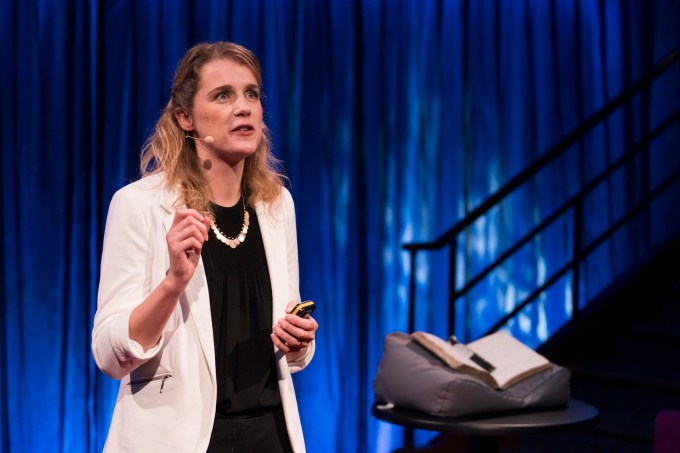
During her talk on how radio waves can send huge volumes of information through the air, Danielle George showed one of Michael Faraday’s original notebooks from the Royal Institution archives. Faraday is not only the namesake of the lecture hall where TEDGlobal>London was held — he demoed electromagnetic induction here in 1831. Photo: James Duncan Davidson/TED
And now, the talks in session 2:
A massive extension of the Internet. More than 4 billion people worldwide don’t have access to the Internet, and with little energy infrastructure in developing countries to support traditional broadband and wifi, it will be a challenge to get it soon. This phenomenon, known as the digital divide, stands between people and information. Harald Haas uses off-the-shelf LED lights and solar cells to transmit data — a breakthrough that may help close the digital divide without a massive spike in energy consumption. For the first time in public, Haas demoed his technology, showing how light emitted by an LED could make a video play on a computer connected to a solar panel. The video data is encoded in fast, subtle fluctuations in the brightness emitted by the LED. The solar panel detects those changes as it harvests the light, the computer decodes those changes, and the video plays. Using this technology, any existing solar panel — on objects, houses and more — can be adapted to receive broadband signals. Watch Harald Haas’ TED Talk >>
The invisible power of radio waves. “You’re bathing in a sea of electromagnetic waves,” says engineer and scientist Danielle George, who taps the invisible energy of radio waves to send huge volumes of information through the air. These wireless transmissions promise to unleash a tsunami of data from unlikely places. Sensors beneath the soil of a farm can transmit vital information about moisture and nutrients. Sensors in a jet engine could transmit a live feed of information to maintenance crews. And it only gets bigger from there. George introduces us to the Square Kilometre Array, which is 50 times more sensitive than any other radio instrument. “We’ve broadcast radio signals into deep space for century and it’s allowed us to realize how much of the universe is beyond what we think we know,” says George. “It will expand our knowledge of the overall universe.”
Why CRISPR demands caution. Jennifer Doudna and her colleague Emmanuelle Charpentier invented CRISPR-Cas9, a technology that lets scientists delete or insert specific bits of DNA in cells. It allows the human genome to be “edited.” Easily. “Genome engineering has been in development since the 1970s, but the techniques were either inefficient or difficult enough to use that most scientists have not adopted them,” says Doudna. “This is a technology that’s analogous to the way we use a word processing program to fix a typo in a document.” CRISPR-Cas9 finds sequence matches and functions like a pair of scissors to make cuts. It has incredible potential to help scientists cure diseases. “But we have to consider that CRISPR could be used for enhancement — we could make a person with stronger bones or less susceptibility to cardiovascular disease,” says Doudna. And with this comes the potential for “designer humans.” Doudna and Charpentier want to slow down. They’ve called for a global pause in research until the social and ethical implications can be thought through. “This is no longer science fiction … This needs careful consideration and discussion,” says Doudna. “It may not be possible to come up with a consensus view, but we need to understand all the potential issues.” Watch Jennifer Doudna’s talk >>
Intrigued by spam. James Veitch responds to the spam emails you most likely delete. A few years ago, he responded to an email from a man who offered to cut him in on a deal involving a large quantity of gold. Email by email, Veitch narrated their months-long exchange, which included discussions of what they would do with their newfound wealth, a dubious set of code words and, of course, a request for Veitch to send some money.
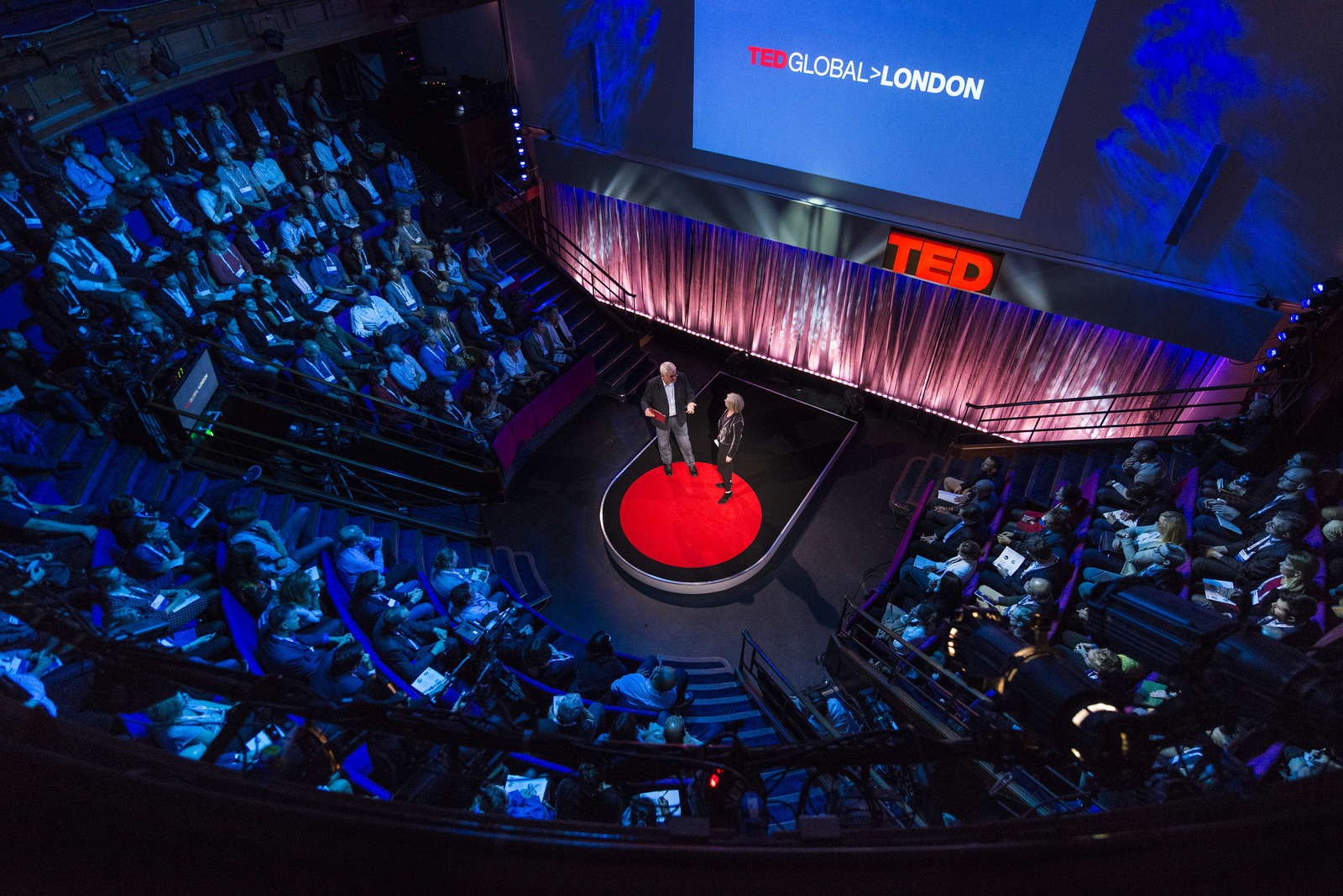
TEDGlobal curator Bruno Giussani interviewed Jennifer Doudna, one of the inventors of CRISPR-Cas9, a tool that allows for the editing of the human genome. Doudna wants to quarantine the research until the ethical implications can be thought through. Photo: James Duncan Davidson/TED
How to be a global reader. Writer Ann Morgan considered herself well read — until she realized the “massive cultural blindspot” in her bookshelf. Amid legions of English and American authors, there were very few (translated) works from authors beyond the English-speaking world. To see what she was missing, Morgan committed to finding and reading one book from each of the world’s 196 countries. From an orgy in a tree in Angola to the confessions of Kuwait’s Bridget Jones, her literary odyssey offered glimpses of worlds almost entirely unknown to English speakers. But the most amazing part was how people around the world jumped to help her find books — they even offered to translate untranslated works into English. “Little by little, that long list of countries that I’d started the year with morphed from a rather dry, academic register of place names into living, breathing entities,” says Morgan. She urges other Anglophones to read translated works for themselves, so that publishers might take notice and bring the world’s literary gems back to their shores. Watch Ann Morgan’s TED talk >>
Turning mass surveillance into art. The revelation that the NSA and GCHQ had mounted antennas to the roofs of the American and British embassies to spy on the German governmental district in Berlin — including German Chancellor Angela Merkel — enraged the international community. In the outrage, artists Christoph Wachter and Mathias Jud saw opportunity. “If people are spying on us,” Jud says, “it stands to reason that they have to listen to what we are saying.” Wachter and Jud started the “Can you hear me?” project, mounting antennas on the roofs of the Swiss Embassy and the Academy of the Arts in Berlin that established an open network that allowed people to send anonymous text messages, emails and voice chats to those listening on the intercepted frequencies. More than 15,000 messages showed the growing discontent with surveillance, and looked forward to a future in which citizens will not be constantly monitored by their governments. “We should start making our own connections, fighting for the idea of an equal and globally connected world,” Jud urges. “This is essential to overcome our speechlessness and the separation provoked by rival political forces.” Watch Mathias Jud and Christoph Wachter’s TED talk >>
In a cave, clues to the world’s evolution. Francesco Sauro explores “alien worlds” on Earth — he studies life in yet-undiscovered caves. Caves tend to form in areas where water dissolves soluble rock. But that’s not the case in the tepuis — the tall, flat mountains that lord over the Brazilian and Venezuelan rainforest. The tepuis are made of quartz, one of the hardest rocks — and yet, cave formations snake through its mountains. Sauro takes us inside one of them, called Imawarì Yeuta, or “House of the Gods” in the indigenous language. Imawarì Yeuta is “a labyrinth of passages” that offers “snapshots of the past.” Its mineral formations are almost unimaginably strange — stalagmites of opal, “mushrooms” of silica, “monster eggs” of an unidentified substance. Life inside these caves has been isolated from the rest of the world for, probably, eons. “Everything you can find there, even a cricket, has evolved in the dark in isolation,” he says. Some could provide clues to the origins of life. Watch Francesco Sauro’s TED talk >>
How two kids made big change. Plastic bags are essentially indestructible, but they’re used and thrown away with reckless abandon. Even in the small island nation of Bali, whose population is just north of 4 million, 680 cubic meters of plastic garbage are produced each day. Most end up in the ocean, where they pollute the water and harm marine life, or burned in garbage piles, where they release harmful dioxins into the atmosphere. Two sisters — Melati and Isabel Wijsen, 14 and 12 years old respectively — are on a mission to stop plastic bags from suffocating their beautiful island home. The young activists started Bye Bye Plastic Bags. Their efforts — a petition, beach cleanups, even a hunger strike — paid off when they landed a meeting with Bali governor I Made Mangku Pastika. He recently committed to a plastic-bag-free Bali by 2018. The sisters provide an inspiring example. “Don’t ever let anyone tell you that you’re too young or you won’t understand,” Isabel says, “We’re not telling you it’s going to be easy, we’re telling you it’s going to be worth it.” Watch Melati and Isabel Wisjen’s TED Talk >>
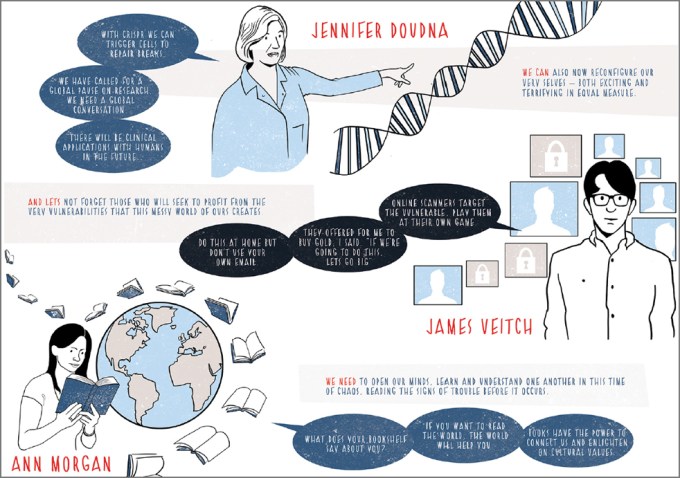
While the speakers shared their ideas at TEDGlobal>London on September 29, graphic artist Eddie Jacob sat in the balcony of the historic Faraday Lecture Theatre “visually scribing” the conference — in other words, drawing a summary of each talk. Jacob is the art director of Innovation Arts, and turned his visual notes into a PDF, which you can download in full.
Download the full program brochure for TEDGlobal>London as a PDF »
Comments (1)